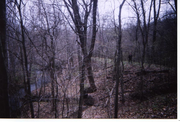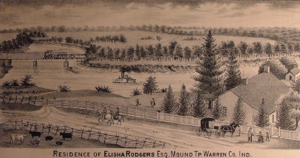
Pumpkin Vine Railroad
Encyclopedia


Chicago, Danville and Vincennes Railroad
The Chicago, Danville and Vincennes Railroad was a railroad established in 1865 that served various communities along the eastern border of Illinois...
(also known as the "Pumpkin Vine Railroad") was constructed in 1872 from Bismarck, Illinois
Bismarck, Illinois
Bismarck is a village in Newell Township, Vermilion County, Illinois, United States. It is part of the 'Danville, Illinois Metropolitan Statistical Area'. The population was 542 at the 2000 census.-History:...
, across Warren County, Indiana
Warren County, Indiana
Warren County lies in western Indiana between the Illinois border and the Wabash River in the United States. Before the arrival of non-indigenous settlers in the early 19th century, the area was inhabited by several Native American tribes. The county was officially established in 1827 and...
, across the Wabash River
Wabash River
The Wabash River is a river in the Midwestern United States that flows southwest from northwest Ohio near Fort Recovery across northern Indiana to southern Illinois, where it forms the Illinois-Indiana border before draining into the Ohio River, of which it is the largest northern tributary...
near the river town of Baltimore, to Covington
Covington, Indiana
Covington is a city located on the western edge of Fountain County, Indiana. The population was 2,645 at the 2010 census. The city is the county seat of Fountain County.-Geography:Covington is located at ....
in Fountain County
Fountain County, Indiana
Fountain County lies in the western part of the U.S. state of Indiana on the east side of the Wabash River. The county was officially established in 1826 and was the 53rd in Indiana. The county seat is Covington....
. There it connected with an existing line that carried coal north to Covington from the coal mines at Snoddy's Mill in the Coal Creek area, a few miles to the south. The area was also known as Stringtown because it consisted of a series of small settlements; this name is still used locally.
Sumner Station was located near the intersection of this new line with the existing Wabash Railroad
Wabash Railroad
The Wabash Railroad was a Class I railroad that operated in the mid-central United States. It served a large area, including trackage in the states of Ohio, Indiana, Illinois, Iowa, Michigan, Missouri and Ontario. Its primary connections included Chicago, Illinois, Kansas City, Missouri, Detroit,...
; G. W. Johnson saw an opportunity and established the town of Johnsonville
Johnsonville, Indiana
Johnsonville is a small town in Steuben Township, Warren County, Indiana.- History :Johnsonville was platted July 8, 1874 by John R. Johnson, Senior, near Sumner Station. A post office was established there on December 2, 1875, with George W. Johnson as postmaster...
at this intersection, and a post office opened there on December 2, 1875. There was a labor riot at the mines in Stringtown in April 1878; Governor James D. Williams
James D. Williams
James Douglas Williams , nicknamed Blue Jeans Bill, was a farmer and Democratic politician who held public office in Indiana for four decades, and was the only farmer elected as the Governor of Indiana, serving from 1877 to 1880...
sent the Wabash Guards to maintain order, but four men were killed; this situation brought a sudden end to the supply of coal from the mines, and by 1880 trains had stopped running on the "Pumpkin Vine". The rails were taken up within a few years.
As of 2007, there are still several places where traces of the grade
Land grading
Grading in civil engineering and construction is the work of ensuring a level base, or one with a specified slope, for a construction work such as a foundation, the base course for a road or a railway, or landscape and garden improvements, or surface drainage...
can be seen, and in a few wooded areas small sections of the grade are virtually untouched (though of course grass-covered and with no ties or rails).

